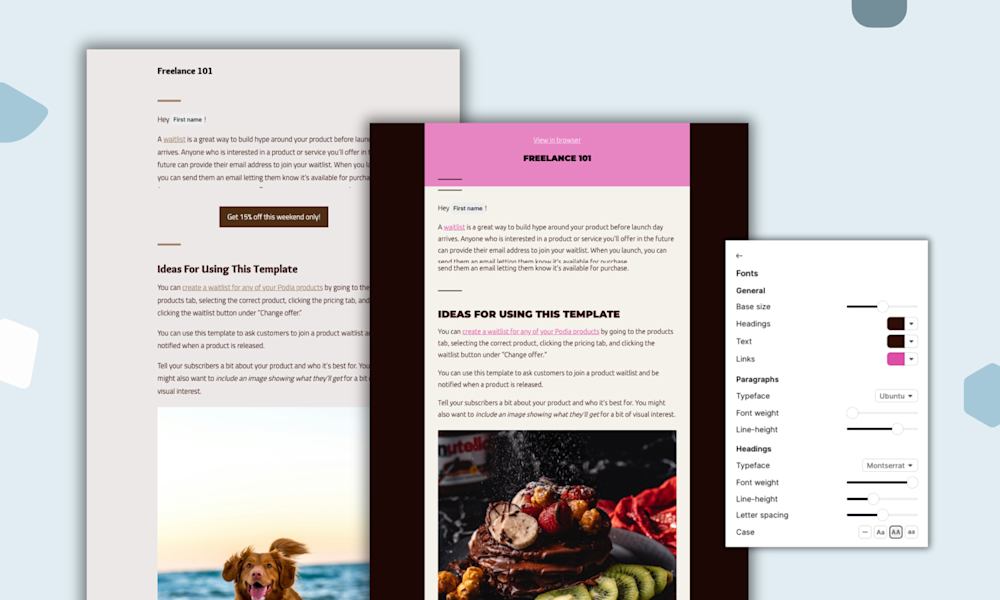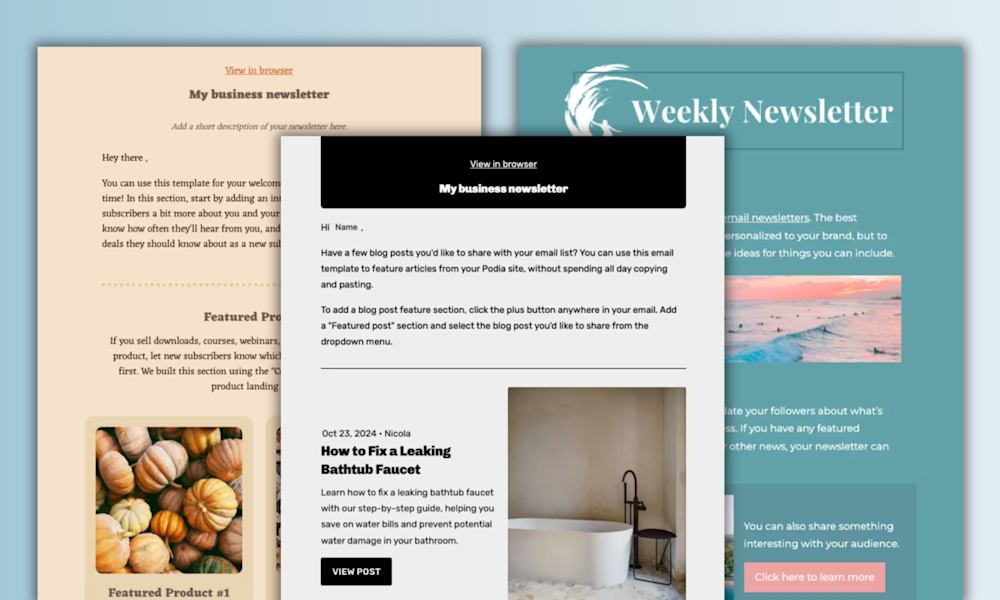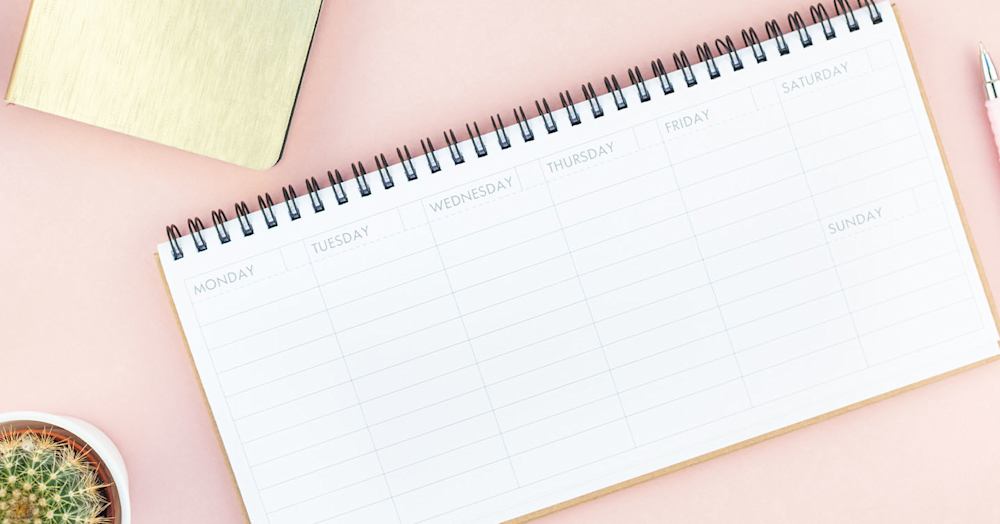I have a confession:
Even as a professional writer, writing sales emails is hard.
Heck, sending sales emails is hard.
There's so much riding on them. Get it wrong, and your list might as well implode because it definitely won't help your bottom line. Get it right, though, and you can take your digital product ideas from rough sketch to profitable finish.
Today, we’re going to help you get it right with eight easy plug-and-play sales email templates.
Before we get to the templates, though, first we need to break down what’s inside a good sales email so you can edit these templates for maximum impact in your business.
What should I include in my sales emails?
There are three main pieces to include in a great sales email: an open-worthy subject line, a question that makes your audience ponder, and a compelling call-to-action (CTA).
Starting with the first component, subject lines play a pretty big role in your email campaigns.
So much so that as much as 47% of email recipients open their emails based on just the subject line.
While there are formulas for creating the best email subject lines -- like most everything in your business -- the only surefire way to optimize your subject lines is to test them.
Another important element to include in your sales email is a thought-provoking question.
What’s the best way to make someone seriously consider your brand as they’re reading your sales email?
Ask a personalized question.
Personalization is so powerful that, if you personalize your email, you’ll enjoy a transaction rate that’s six times higher than one’s that’s not personalized.
Check out how Thrive Themes starts off with a personalized question that makes you think about an annoying problem that you’ve experienced while visiting other sites.
Not to mention, the subject line, “This is SO annoying... don’t do this on your site,” is a perfect match for agitating the addressed problem.
Plus, by putting you in the shoes of the annoyed user -- from subject line to the intriguing question -- you’re now able to empathize a lot more with your own visitors.
Hopefully, enough to want to prevent them from experiencing the same frustration.
Pretty personal and thought-provoking, right?
So is the third sales email element: a compelling CTA in your sales email.
Your CTA can be as involved as asking your readers to sign up for an online course, like in the same Thrive Themes example, where it includes a CTA to register for a mini-course that solves the mentioned problem.
Or your CTA can be as simple as asking your recipients to access a helpful resource, like in this MarketingProfs email with a CTA link to its guide on Agile Event Programs That Can Survive Anything.
Regardless of what action you want your reader to take after reading your email, the idea is to include at least one. The point of sending your sales email, after all, is to get them to do something.
But OK, that covers the anatomy of your sales email. Now let’s get to those templates.
8 sales email templates to swipe for your campaign
Type #1: Welcome email
The first email template to swipe is the welcome email, which is particularly important because it’s an email that’s in the spotlight in a big way.
Welcome emails score an average open rate of over 82% with an average click-through rate that’s close to 27%.
Pretty staggering numbers, right?
So, as you build your email list, keep in mind the significance of your opening welcome email and send a welcome message immediately after your audience opts in for your resource -- whether it’s a paid or unpaid one.
Who it’s for: Welcome emails are for new subscribers or customers that just joined one of your email lists after opting in for something you offer.
The purpose: To get your recipient to engage with your brand.
The template:
Type #2: Adding value email
Our next template for you today is an email that features valuable content. It’s designed to provide your audience with value while building up your brand as an expert resource for your topic.
If you’re wondering what format to use for adding value, consider writing blog content.
After all, it’s becoming increasingly effective, with an overwhelming 71% of B2B respondents from a Demand Gen report claiming they consume blog content during their purchasing process.
Even if you don’t send a link to your blog article in your email, you can still add value by providing helpful resources -- like tips, how-to’s, guides, tutorials, lessons, and et cetera -- to your recipients.
Who it’s for: Anyone on your email list at any point in the buyer’s journey. As you know, personalization goes a long way, so tailor your valuable resource to your recipient’s stage in their purchasing process.
The purpose: To build rapport and trust while getting your recipient to engage with your brand.
The template:
Type #3: Pain point email
Another email template file to snatch is one that addresses your audience’s pain point.
If you’re looking for direction on how to describe your audience’s pain point, look no further than Joanna Wiebe, the founder of Copyhackers and an expert on using copy as your top online salesperson.
Joanna uses a process she calls writing about your audience’s moment of highest tension (MOHT), where you basically illustrate -- through copywriting, of course -- a very detailed and vivid image of your audience’s worst moment as it relates to your solution for them.
The point is to agitate your audience’s problem while empathizing with them.
Who it’s for: People who are mostly aware of their problem and on the brink of considering a solution.
The purpose: To crystalize your prospective client’s problem and describe it as accurately as possible, so your brand becomes a trustworthy resource and/or solution for them.
The template:
Type #4: Testimonial email
Another powerful sales email type is one that features social proof. For emails, we recommend highlighting a testimonial that shows off one of your previous clients getting their desired results.
Why?
Testimonials work wonders. So much so that 92% of consumers read testimonials and online reviews when they’re considering a purchase, and 88% of them trust online reviews as much as personal recommendations.
So, if you’re on the fence about getting testimonials from current and past clients, the jury is out. It’s time to put in the extra effort to get better reviews and testimonials that you can feature in your sales emails.
Who it’s for: Anyone considering a way to solve their problem.
The purpose: To build rapport, credibility, and trust among your audience and convince them you’re a reliable solution to their problem.
The template:
Type #5: Featuring results email
Our fifth email template for you today is an email that speaks to your audience’s goal and desired results. It’s a way to get them to imagine a (future) life with their problem solved.
As far as how to do it, let’s go back to our copywriting queen, Joanna Wiebe, who recommends resolving your audience’s MOHT with a moment of highest pleasure (MOHP) by explaining it in an illustrative and detailed way.
If you’re wondering why visualization works, author Eric T. Whitmoyer explains in his book, Success With Goals:
“According to researchers using brain imagery, visualization works because neurons in our brains, those electrically excitable cells that transmit information, interpret imagery as equivalent to a real-life action.”
Who it’s for: Prospective clients who are considering a solution to their problem. They’re aware of their problem and need to decide on how they’re going to address it.
The purpose: To nudge your reader to consider your offer as the solution to their problem.
The template:
Type #6: Overcoming objections email
This email template is for overcoming your audience’s objections. It’s a way to squash their resistance and address what’s holding them back from taking you up on your offer.
For instance, if one of your audience’s big objections is pricing -- which is one of the biggest challenges businesses face, with 35% of salespeople claiming it as a top challenge -- then address your price and find a way to lift your perceived value.
If you’re having trouble differentiating your product, something that 15% of salespeople find challenging, make a more compelling case to choose your brand over a competitor’s.
Whatever the objection is, address it head-on in your sales email -- and customize it to your audience, of course -- so you can overcome the sales challenge.
Who it’s for: People who haven’t purchased from you yet, but are a good fit for your offer.
The purpose: Remove any blocks that are preventing your audience member from purchasing from you.
The template:
Type #7: Pitch email
Our seventh template for you is the pitch email, where you make your big offer to your audience.
There’s a lot of pressure riding on this email, but it’s not as big of a deal as it might seem. It’s just one small part of the puzzle.
All the emails in your email marketing campaign work together to make sales.
So, it’s worth noting that you can (and should) make additional pitches in subsequent follow-up emails.
If you do, you’ll increase your chances of seeing some engagement from your audience. In fact, more follow-up emails can triple your reply rate.
According to a Woodpecker study that analyzed over 20 million emails, sending an email sequence with 4-7 emails returned an average reply rate of 27% compared to only 9% for an email sequence with 1-2 emails.
So, don’t be afraid to send variants of your pitch email with a series of follow-up emails. It can only really help.
Who it’s for: Prospective clients who are familiar with your brand’s offer and are a good fit for your offer.
The purpose: To get your audience to purchase your offer from you.
The template:
Type #8: Win-back email
Our final type of email today is a win-back email that re-engages your inactive audience members.
If you’re wondering how long before a customer becomes inactive, it varies across industries and products.
But we can look to the ecommerce world for a rule of thumb, which is three months of inactivity indicating your customer is at risk of lapsing and 6-9 months of inactivity signaling they no longer interact with your business.
Regardless of the time frame, give your audience an enticing reason to re-engage with your business in your win-back email. And, like all of these templates, test sending a series of them with different elements to see which combo wins back the most customers.
Who it’s for: Inactive subscribers or customers who have fallen off in their activity level.
The purpose: To get your audience to engage again with your brand after a hiatus or period of inactivity.
The template:
Mix and match these sales email templates to suit your business
Selling your digital products can be done without reinventing the wheel, especially when you have reliable files to swipe.
Use these eight sales email types for your email marketing campaigns:
-
Welcome email
-
Adding value email
-
Pain point email
-
Testimonial email
-
Featuring results email
-
Overcoming objections email
-
Pitch email
-
Win-back email
This list doesn’t cover every type of sales email you may need to send over the life of your business, but it’s a strong start. Use these email templates to build your sales email sequence and start converting subscribers into customers today.



